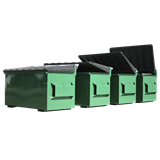The State of the Environment report for 2012, prepared by the Environment Protection Authority (EPA), shows people in NSW are adopting more sustainable lifestyles and key environmental indicators for land, air and water have improved since the last report was released three years ago.
Waste recycling is up 59 per cent compared with 2008-9 and residential electricity and water consumption rates have fallen, the report found.
More people are electing to use public transport, especially in Sydney, even though there are now three cars for every two households.
Air quality continues to improve, and can be better outdoors than inside.
But those seeking a breath of fresh air will have to contend with the "persistent problem" of noise pollution.
Noise complaints to the state's environment hotline were up 39 per cent in 2010-11 compared with 2007-8.
Forests and wetlands are under threat, with the report noting "habitat destruction, including clearing, and invasive species are the greatest threats to biodiversity in NSW" and the condition of most native vegetation has deteriorated.
Another 35 native species have been listed as endangered since 2009, prompting the NSW Greens to warn of a biodiversity crisis.
"What we are seeing at the moment is death by a thousand cuts," Greens environment spokeswoman Cate Faehrmann said on Thursday.
"This government has done zip. Instead it has sent very strong signals that it's going to weaken laws designed to protect threatened species.
"What is urgently needed is a serious regulatory approach from the government that will halt the decline in the state's biodiversity, not exacerbate it."
The report warns introduced plants and animals including foxes, feral cats, rabbits and goats pose a major threat to the survival of many native species.
It also notes that, while chemical contamination of land, food and produce is low and stable, "hazardous chemicals in consumer products has been identified as an emerging issue"
- Suppliers
- New to HospitalityHub? Book a Demo
- Advertise with us
- Login
- Email Marketing
- Buyers
- Get Quotes
- Articles & Ideas
- Login
- Subscribe to newsletter
- My Details
- Get Quotes
- Bakery & Dough Processing Equipment
- Bar Equipment & Barware
- Bathroom Fixtures & Accessories
- Chocolate Making Machinery
- Cleaning & Housekeeping
- Commercial Coffee Equipment
- Commercial Cooktops
- Commercial Fridges & Freezers
- Commercial Kitchen Equipment
- Commercial Ovens
- Dish, Utensil & Glass Washing
- Entertainment & Outdoor
- Food Packaging & Ingredients
- Food Preparation Equipment
- Furniture & Fixtures
- Pizza & Pasta Making Equipment
- Point of Sale, AV & Technology
- Get Quotes
- Bakery & Dough Processing Equipment
- Bar Equipment & Barware
- Bathroom Fixtures & Accessories
- Chocolate Making Machinery
- Cleaning & Housekeeping
- Commercial Coffee Equipment
- Commercial Cooktops
- Commercial Fridges & Freezers
- Commercial Kitchen Equipment
- Commercial Ovens
- Dish, Utensil & Glass Washing
- Entertainment & Outdoor
- Food Packaging & Ingredients
- Food Preparation Equipment
- Furniture & Fixtures
- Pizza & Pasta Making Equipment
- Point of Sale, AV & Technology
Trusted by 200,000+ Australian hospitality buyers
Buyers
- Discover products & solutions
- Login
- Subscribe To Newsletter
- Browse All Products
- Read Articles
Suppliers
Advertise
- Promote your products & solutions
- New to HospitalityHub? Book a Demo
- Login / Forgot Password
- Advertise Your Products
- Success Stories
- Email Marketing
Trusted by 200,000+ Australian hospitality buyers



